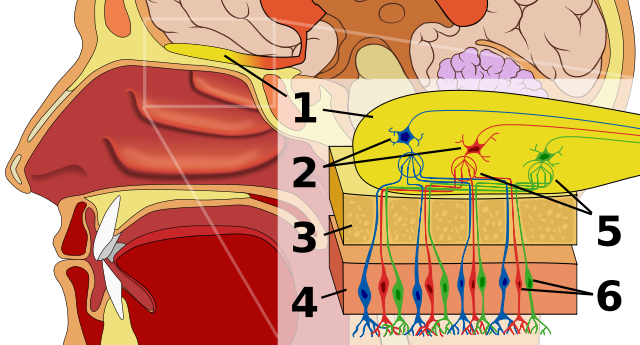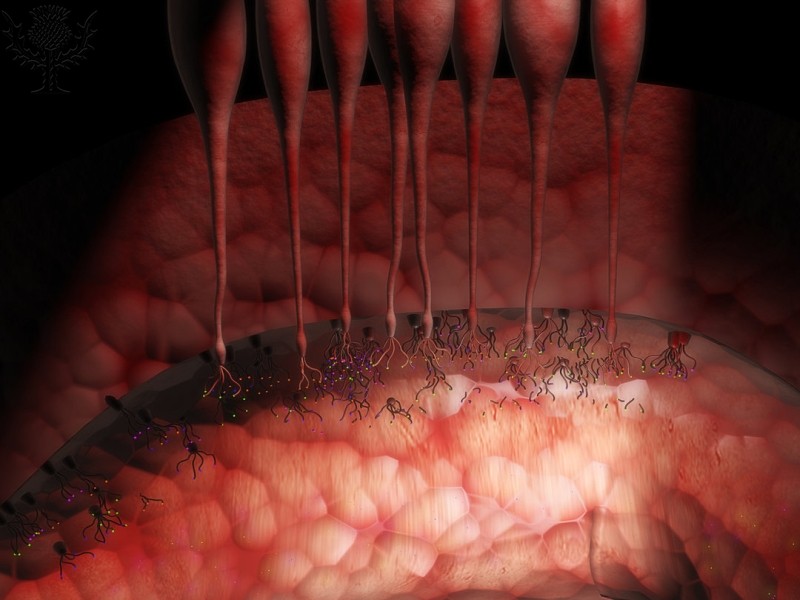Special Senses
The sense of smell
Our other chemical sense is the sense of smell or olfaction. In contrast to taste cells, which are epithelial derived, olfactory receptor cells are neurons. But similar to taste cells, olfactory receptor neurons have a relatively short life span, about 2 months, and must be replaced. The ability to grow in cycles (4 to 8 weeks) places olfactory neurons in a unique class within the nervous system as the only neurons that routinely die and are replaced. Olfactory receptor neurons are located within the olfactory epithelium, a 10 cm2 area located high in the roof of the nasal cavity. Animals with a more highly developed sense of smell have many more olfactory receptors than humans. For example, some dogs have an olfactory epithelium with 100 times as many olfactory receptor neurons covering an area of 170 cm2. Some breeds of dogs can detect the scents of people hours after the person has left the area. The title for all time best smeller goes to the bear. Black bears have been known to travel 18 miles in a straight line to a food source. African Elephants also have an excellent sense of smell and can detect water up to 12 miles away.

© 2013 Encyclopædia Britannica, Inc. Downloaded from Image Quest Britannica; BYU-Idaho.
At the top of this image we see olfactory neurons of the olfactory epithelium communicating with the olfactory bulb. The facial nerve and glossopharyngeal nerve innervates the anterior and posterior tongue. This is also shown.

Title: File:Olfactory System.svg; Author: Chabacano; Site: https://commons.wikimedia.org/wiki/File:Olfactory_system.svg; License: This file is licensed under the Creative Commons Attribution-Share Alike 2.5 Generic license.
The image above Shows (1) Olfactory bulb; (2) Mitral Cells; (3) Bone; (4) Olfactory Epithelium; (5) Glomerulus; (6) Olfactory neurons

Smell receptors, computer artwork. Photography. Encyclopædia Britannica ImageQuest. Web. 19 Jun 2015. Citation Search
Illustration of the location of the olfactory neurons (neurons at the top of the nasal cavity). These are bipolar neurons whose axons extend through the cribriform plate to the olfactory bulb. Note the cilia (olfactory hairs) extending into the mucous lining the olfactory epithelium.
The olfactory epithelia contains millions of olfactory sensory neurons that can detect more than 400,000 different substances, by some estimates, and more than 1.7 trillion, yes 1.7 trillion different smells (Bushdid et al., 2014; Science). As we breath, chemical odorants are mixed with the air as they pass through the many folds in the nasal passages. In order for us to smell, the odorant must first be dissolved in a thin water-based mucous layer that lines the olfactory epithelium. Dissolved odorants then bind to receptors located within membranes of the receptor cilia of the olfactory neuron (see image above). Olfactory receptors are G protein coupled receptors that activate the enzyme adenylyl cyclase. The activated adenylyl cyclase in turn produces cAMP which opens a cation channel, allowing Na+ and Ca++ to enter the cell. The influx of the positively charged ions depolarizes the membrane triggering an action potential.
The olfactory sensory neurons synapse with neurons in the olfactory bulb that extend to the olfactory cortex. Neurons from the olfactory tract pass either to the olfactory epithelium in the temporal lobe where odor is perceived or to areas in the frontal lobe where emotions associated with the odor are generated. These areas are associated with the limbic system and can generate emotional and visceral responses to the smell. Recall that the sense of smell is the only major sense that does not pass through the thalamus. It is considered to be a very primitive sense and is important in emotion and memory. You may have observed an increase in emotional responses to smells during pregnancy. It is thought that the hormones of pregnancy enhance the cortical regions of smell so that the woman becomes more sensitive to certain odors.
**You may use the buttons below to go to the next or previous reading in this Module**


